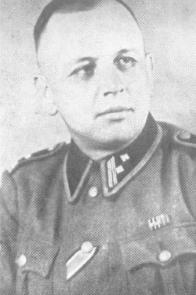Sturmscharführer on:
[Wikipedia]
[Google]
[Amazon]
__NOTOC__
(, ) was a Nazi rank of the
 ''Sturmscharführer'' as a proper rank was unique to the Waffen-SS and was not used in the ''
''Sturmscharführer'' as a proper rank was unique to the Waffen-SS and was not used in the ''
File:SS-Sturmscharführer h.svg ,
Waffen-SS
The (, "Armed SS") was the combat branch of the Nazi Party's ''Schutzstaffel'' (SS) organisation. Its formations included men from Nazi Germany, along with Waffen-SS foreign volunteers and conscripts, volunteers and conscripts from both occup ...
that existed between 1934 and 1945. The rank was the most senior enlisted rank in the Waffen-SS, the equivalent of a regimental sergeant major
Regimental sergeant major (RSM) is an appointment that may be held by warrant officers class 1 (WO1) in the British Army, the British Royal Marines and in the armies of many other Commonwealth and former Commonwealth nations, including Australia ...
, in other military organizations.
Rank usage
 ''Sturmscharführer'' as a proper rank was unique to the Waffen-SS and was not used in the ''
''Sturmscharführer'' as a proper rank was unique to the Waffen-SS and was not used in the ''Allgemeine-SS
The ''Allgemeine SS'' (; "General SS") was a major branch of the ''Schutzstaffel'' (SS) paramilitary forces of Nazi Germany; it was managed by the SS Main Office (''SS-Hauptamt''). The ''Allgemeine SS'' was officially established in the autumn ...
'' (general-SS), where the highest enlisted rank was ''Hauptscharführer __NOTOC__
''Hauptscharführer'' ( ) was a Nazi paramilitary rank which was used by the ''Schutzstaffel'' (SS) between the years of 1934 and 1945. The rank was the highest enlisted rank of the SS, with the exception of the special Waffen-SS ran ...
''. Members of the '' Sicherheitspolizei'' (SiPo), when wearing the rank insignia of ''Sturmscharführer'' with police collar piping, did so when holding the equivalent police rank of ''Meister'' or the investigator's title of ''Kriminalsekretär''. Administratively, such secret police members were not even required to be members of the SS (although many were) and thus the insignia was sometimes worn by non-SS members. Due to SS rank parity regulations, by 1943 most police members were required to hold SS rank, and those with police equivalent rank to ''Sturmscharführer'' were often administratively enlisted into the Waffen-SS in order to be ranked as a ''Sturmscharführer''.
History
The rank of ''Sturmscharführer'' was first created in June 1934, after theNight of the Long Knives
The Night of the Long Knives (German: ), or the Röhm purge (German: ''Röhm-Putsch''), also called Operation Hummingbird (German: ''Unternehmen Kolibri''), was a purge that took place in Nazi Germany from 30 June to 2 July 1934. Chancellor Ad ...
. Due to a reorganization of the SS, ''Sturmscharführer'' was created as the most senior enlisted rank of the '' SS-Verfügungstruppe'' (SS-VT), replacing the older '' Sturmabteilung'' (SA) title of '' Haupttruppführer''.
By 1941, the Waffen-SS had become the successor organization to the SS-VT and ''Sturmscharführer'' was established as the most senior enlisted rank. A ''Sturmscharführer'' was typically assigned as the head sergeant of an entire regiment or, in some cases, an infantry division.
Insignia
''Sturmscharführer'' was not the same as '' Stabsscharführer'', which was a positional title given to the head SS non-commissioned officer of a company. The rank of ''Sturmscharführer'' was also not a prerequisite for promotion to ''Untersturmführer
(, ; short: ''Ustuf'') was a paramilitary rank of the German ''Schutzstaffel'' (SS) first created in July 1934. The rank can trace its origins to the older SA rank of ''Sturmführer'' which had existed since the founding of the SA in 1921. ...
'' and was generally considered as a rank for "career" enlisted SS soldiers, rather than a rank on the path to becoming an officer.
The insignia for ''Sturmscharführer'' was two silver pips and two silver stripes worn on a collar patch along with the shoulder boards of a Wehrmacht
The ''Wehrmacht'' (, ) were the unified armed forces of Nazi Germany from 1935 to 1945. It consisted of the ''Heer'' (army), the '' Kriegsmarine'' (navy) and the ''Luftwaffe'' (air force). The designation "''Wehrmacht''" replaced the previo ...
''Stabsfeldwebel
''Stabsfeldwebel '' (StFw or SF; ) is the second highest Non-commissioned officer (NCO) rank in German Army and German Air Force. It is grouped as OR-8 in NATO, equivalent to a First Sergeant in the United States Army, and to Warrant Officer C ...
''. As was the case with Waffen-SS enlisted insignia, the collar patch of a ''Sturmscharführer'' was edged with black-and-silver twist cord until 1940 when the edging was dropped; like all non-commissioned officers the collar was bordered with 9mm silver-grey braid.
Insignia Waffen-SS
Shoulder strap
A shoulder strap is a strap over a shoulder. They are often affixed to women's dresses to support its weight or as part of its style. The term is also applied to carrying bags.
Dress shoulder strap
Image:Camisole.png, Camisole
Image:Preprom.jpg, ...
File:SS-Sturmscharführer.svg , Gorget patches
Gorget patches (collar tabs, collar patches) are an insignia in the form of paired patches of cloth or metal on the collar of a uniform (gorget), used in the military and civil service in some countries. Collar tabs sign the military rank (group o ...
File:StFw Stuscha OR8 cam slv 1945.svg , SS smock insignia
See also
*Table of ranks and insignia of the Waffen-SS
__NOTOC__
This table contains the final ranks and insignia of the Waffen-SS, which were in use from April 1942 to May 1945, in comparison to the Wehrmacht. The highest ranks of the combined SS (german: Gesamt-SS) was that of and ; however, the ...
Notes
Bibliography
* * * {{DEFAULTSORT:Sturmscharfuhrer SS ranks